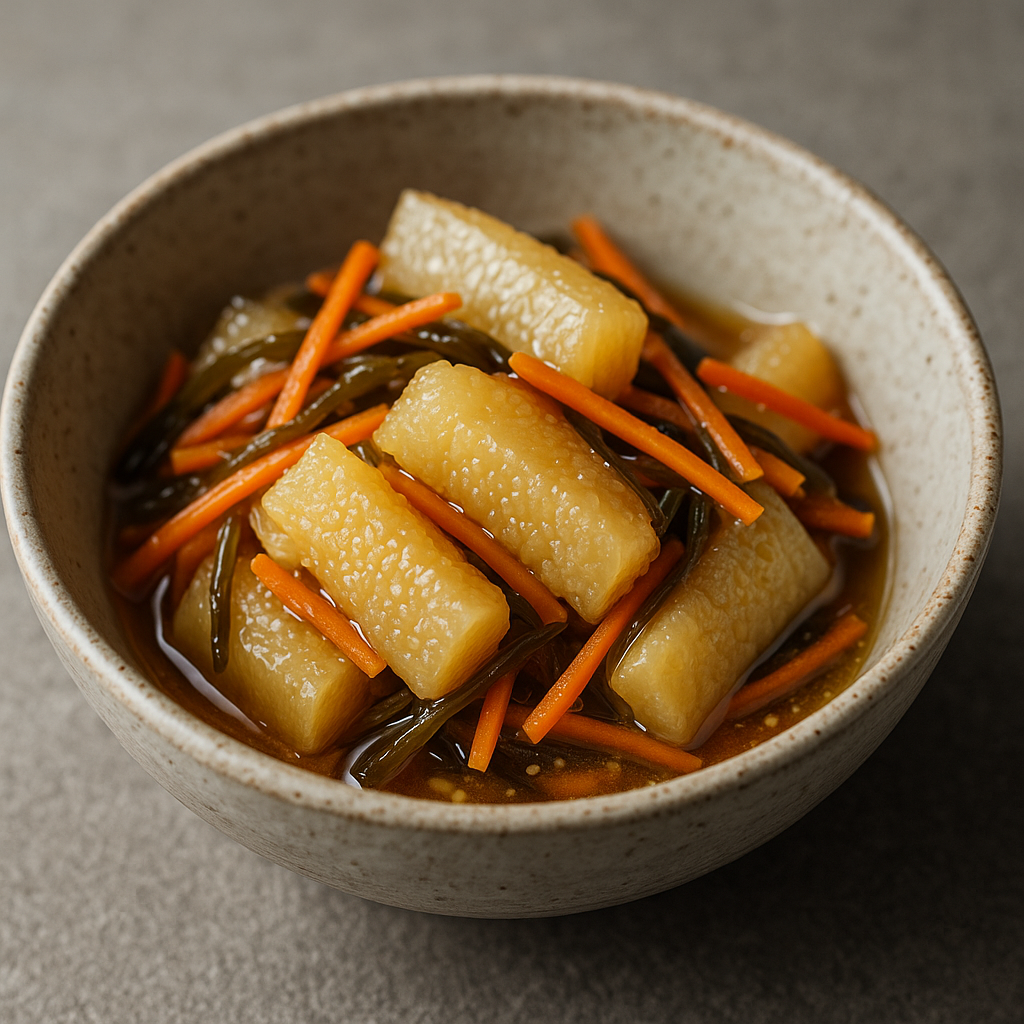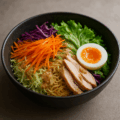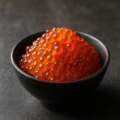松前漬けの特徴
北海道を代表する郷土料理
松前漬けは、北海道松前町発祥の郷土料理で、数の子・スルメ・昆布を醤油やみりんに漬け込んだ保存食です。海の幸の旨味が凝縮され、正月料理としても定番です。
数の子の食感と旨味
ぷちぷちとした数の子の食感に、昆布やスルメの旨味が合わさり、奥深い味わいを楽しめます。
保存食からご飯のお供へ
かつては冬の保存食として作られていましたが、現在ではご飯や酒の肴に人気の一品となっています。
松前漬けのレシピ
材料(4人分)
- 数の子(塩抜きしたもの) … 150g
- スルメ … 30g
- 昆布 … 20g
- 醤油 … 100ml
- みりん … 50ml
- 酒 … 30ml
- 砂糖 … 大さじ1
- 鷹の爪 … 1本(輪切り)
作り方
- 数の子は塩抜きして食べやすく切る。
- スルメと昆布は細切りにする。
- 鍋に醤油・みりん・酒・砂糖を入れ、ひと煮立ちさせて冷ます。
- 保存容器に数の子・スルメ・昆布を入れ、調味液を注ぐ。
- 鷹の爪を加えて冷蔵庫で2〜3日漬け込んで完成。
シェフのワンポイントアドバイス
漬け込むほどに旨味が増すので、最低1週間は寝かせましょう。
砂糖の量はお好みで調整できます。
数の子の塩抜きをしすぎると苦みが出るので、少し塩気が残るぐらいに留めておきましょう。
松前漬けの栄養価(1人分の目安)
- エネルギー:約120〜150 kcal
- たんぱく質:10〜12 g
- 脂質:2〜4 g
- 炭水化物:10〜15 g(調味料由来)
- EPA・DHA(数の子由来)
- 食物繊維(昆布由来)
- ミネラル(カルシウム・マグネシウム)
低カロリーでありながら、良質なたんぱく質やミネラルを摂れる健康的な料理です。
松前漬けの歴史
松前町発祥
松前漬けは、北海道松前町で生まれた郷土料理で、保存食として作られたのが始まりです。
保存食の知恵
寒冷な北海道の気候を活かし、昆布やスルメといった乾物を活用して冬の間の栄養源として重宝されました。
正月料理として定着
数の子を加えることで豪華さが増し、現在では正月料理の定番として全国に広まりました。
English Version
Features of Matsumae-zuke
A Representative Local Dish of Hokkaido
Matsumae-zuke is a traditional preserved dish from Matsumae Town, Hokkaido. It is made by marinating herring roe, dried squid, and kelp in soy sauce and mirin. With its condensed seafood umami, it is also a classic New Year’s delicacy.
Texture and Flavor of Herring Roe
The popping texture of herring roe, combined with the umami of kelp and squid, creates a deep and flavorful taste.
From Preserved Food to Everyday Side Dish
Originally made as a preserved food for winter, it is now widely enjoyed as a side dish with rice or as an accompaniment to sake.
Recipe
Ingredients (for 4 servings)
- Herring roe (desalted) … 150 g
- Dried squid … 30 g
- Kelp … 20 g
- Soy sauce … 100 ml
- Mirin … 50 ml
- Sake … 30 ml
- Sugar … 1 tbsp
- Dried chili pepper … 1 (sliced)
Instructions
- Desalt the herring roe and cut into bite-sized pieces.
- Cut the dried squid and kelp into thin strips.
- In a pot, combine soy sauce, mirin, sake, and sugar. Bring to a quick boil, then let it cool.
- Place the herring roe, squid, and kelp into a container and pour the marinade over them.
- Add chili pepper and refrigerate for 2–3 days before serving.
Chef’s Tip
The longer you let it marinate, the richer the flavor becomes. Ideally, let it sit for at least a week. Adjust the amount of sugar to your liking. When desalting herring roe, avoid over-soaking, as it may bring out bitterness—keep a slight saltiness for balance.
Nutritional Value (per serving, approx.)
- Calories: 120–150 kcal
- Protein: 10–12 g
- Fat: 2–4 g
- Carbohydrates: 10–15 g (mainly from seasonings)
- EPA & DHA (from herring roe)
- Dietary fiber (from kelp)
- Minerals (calcium, magnesium)
Although low in calories, Matsumae-zuke provides high-quality protein and minerals, making it a healthy preserved dish.
Historical Background
Origin in Matsumae Town
Matsumae-zuke originated in Matsumae Town, Hokkaido, where it was first created as a preserved food.
Wisdom of Preservation
Taking advantage of Hokkaido’s cold climate, dried squid and kelp were used with herring roe to provide essential nutrition during the winter.
Established as a New Year’s Dish
By adding herring roe, it gained a festive touch, and over time, Matsumae-zuke became a staple New Year’s dish throughout Japan.



何でも質問してください!